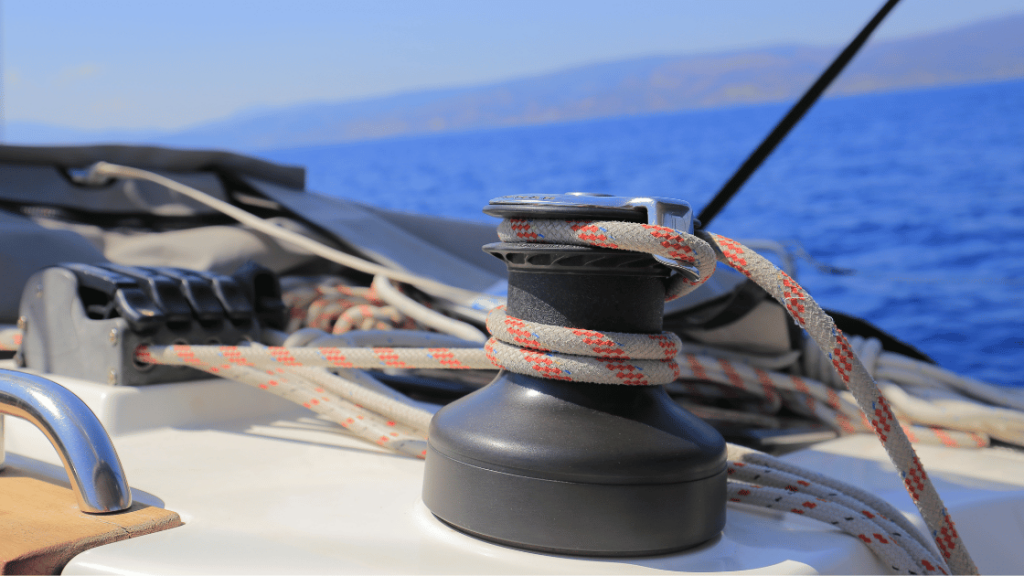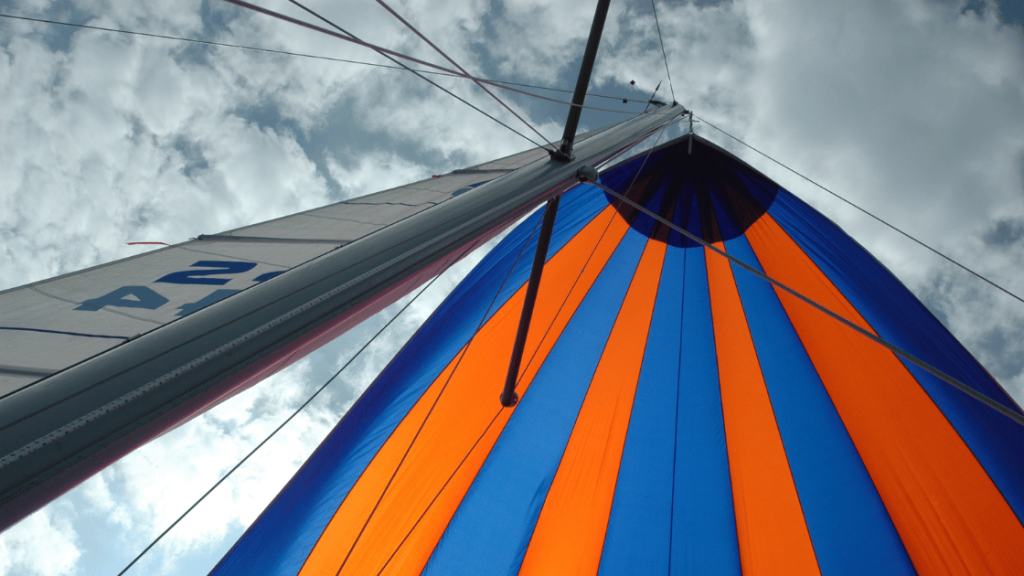Nautical Terminology 101 – Running Rigging
October 5th, 2023 by team

by B.J. Porter (Contributing Editor)
Last month we talked about standing rigging – the fixed, permanent parts of your boat. This month, we’re on to running rigging – the various lines that you move, pull, and release to sail the boat. Running rigging has at least one free end. For this article, we’re talking about the rigging on a modern sloop, a comparatively simple rig compared to many older rig styles.
The astute observer will note I used the word “lines,” not “ropes.” With only a few exceptions, there are no “ropes” on a sailboat. There are many things made of rope on a sailboat, but the proper names for them once they have a job do not include the word “rope.” Sailors talk mostly about lines, sheets, halyards, and so on.
(Ten bonus points for anyone who can name some of the only “ropes” on a boat in the comments. Hint: We find at least one on sails without hanks or cars.)
Sheets

A sheet is a line which controls a sail. It’s used to trim the sail (tighten it in) or ease it (loosen and let it out). The name for the sheet is {sailname} + “sheet.” Sheets always attach to the clew of the sail.
Main sheet – Controls trim on the mainsail. Usually run through a series of blocks to get purchase for easier trimming.
Jib/genoa sheet – Handles the first, largest headsail. They will turn around blocks and run through a car to change sheeting angles, but there isn’t a purchase involved. Instead, headsail sheets run to the primary (largest) cockpit winches. Like the sail name itself, the use of jib and Genoa is often interchangeable and informal. So you may well be flying a giant overlapping Genoa from the headstay while people in the cockpit are telling you to work all the knots and kinks out of the “jib sheet.”
Staysail sheet – if there is a staysail, this runs through its own adjustable deck car back to the cockpit.
Spinnaker sheet – trims the spinnaker, and attaches to the leeward side of the sail (remember windward/leeward from August?).
Headsail and spinnaker sheets are usually paired and run to each side of the boat for use on different tacks and gybes. One line is taught with the sail load, and the other one is the “lazy” sheet, because it isn’t doing anything.
Halyards

Halyards haul sails up to the top of their set position and hold them there. They attach to the head of the sail, run through a sheave at the top or middle of the mast, and back down to deck level. Some halyards are external (outside the mast) but many run inside the mast and only appear through slots near deck level.
Many halyards have a rope clutch on them to hold the rope. But rope clutches can slip a little with high loads, so most also have a cleat or self-tailing winch to ensure there is no slipping once the sail loads up.
Halyards are made from very low stretch lines, and race boats often strip the outer cover off the halyards to save weight.
Primary halyards are the main halyard, jib/genoa halyard, staysail halyard, and spinnaker halyard.
Many boats have one or more spare halyards, in case one breaks or the crew needs to go up the rig while other halyards are in use. Halyards may end at the mast, or run back to the cockpit.
Control lines

Other lines are used to control the sails, trim the rig, and operate the boat. We’ll group them by functional groups, so you can explore and identify them easily the next time you’re on a boat.
IMPORTANT NOTE: Not all boats have all the controls and lines listed.
Mainsail lines
- Outhaul, or clew outhaul – line to the clew of the mainsail that adjusts foot tension and the fullness of the main.
- Cunningham – adjusts the luff tension. It’s usually a line through a grommet near the tack of the sail a little way up the luff.
- Reef lines – used to reef (shorten) the sail, these run through grommets (or cringles) near the luff the sail at fixed reef points.
- Vang – or “Boom vang” runs from the bottom of the boom to the deck and keeps the boom height constant. This may be a block and tackle with lines, or a hydraulic or mechanical cylinder on larger boats.
- Traveler – controls the angle of attack of the mainsail. The mainsheet runs through a block on the traveler, but the traveler itself is an adjustable car usually moved with a line run between blocks for purchase.
- Topping lift – supports the boom from the masthead when the boat is at rest. The topping usually runs to the masthead. Some owners use an old halyard for the topper, so it can act as a spare halyard.
- Leech lines and foot lines – small lines along the edges of the sail to set the tension or curve in the sail edge.
Headsail lines
- Leech lines and foot lines – identical in function on head sails and the mainsail, but headsails don’t have foot lines as often.
- Furling line – manual sail furlers often use a line to turn the furling drum which wraps onto the drum when the sail is out.
- Barber hauler – a temporary replacement sheet run through a separate block to get better sheeting angles sailing off the wind.
Spinnaker and pole lines

Symmetrical spinnakers need more lines than asymmetrical sails, because they use a pole to support the sail and keep it open. The pole must be trimmed to keep the angle of attack correct.
- Spinnaker guy – or “brace” for our friends on the other side of the pond, is the line attached to the windward side of a symmetrical spinnaker. it runs through the spinnaker pole jaws. NOTE: Some boats, usually smaller ones, do not run a separate sheet and guy on each side of the boat. One line runs to each corner of the sail, and is called the sheet when it’s used to trim the sail, and the guy when it trims the pole.
- Tack line – on asymmetrical spinnakers, a tack line runs from the sail tack to a deck fitting or pole. It’s usually adjustable for wind conditions.
- Twing – light line usually with a block to adjust the angle of the spinnaker sheet. Often left off, especially in light air racing.
- Pole downhaul – runs from the bottom of the spinnaker pole to a deck fitting, used to keep the spinnaker pole level and prevent it from “skying” or flying up on the end.
- Pole topping lift – pulls the pole up and level.
Names and Variations
As I hinted with the spinnaker guy/brace name differences between North America and the U.K., there are some different names which may be used based on where you’re sailing. But you may hear a vang called a “kicker” or other terms used that aren’t here for the same things anywhere.
For sure we’ve missed a few things, and I’d love to hear some of your local variations in the comments!


September 27, 2024 at 7:28 am, AngelFuple said:
Спасибо, долго искал
_________________
винлайн букмекерская контора фрибеты
February 16, 2025 at 7:37 pm, Árni Möller said:
Hi,
What is your recommendation for Colour Coding for Running Rigging for the lines above?
Best regards
Árni
Iceland